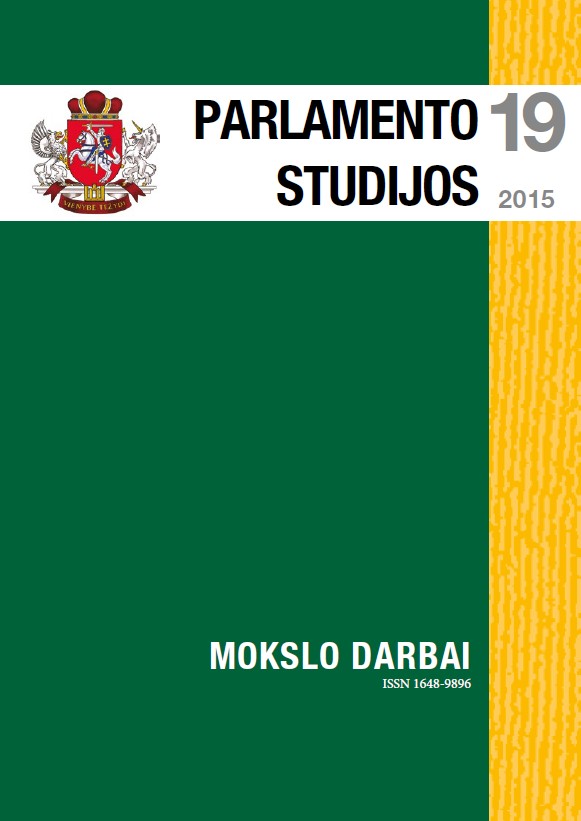Do School Textbooks Develop Democratic Parliamentarians? Parliamentarism of Modern Times in Lithuania, in History Textbooks of 9–12 Grades
DOI:
https://doi.org/10.51740/ps.vi19.180Keywords:
History textbooks, students, the parliamentary history, the Great Seimas of Vilnius, the Constituent Assembly of Lithuania, the People’s Seimas, democracyAbstract
This article analyses the way Lithuanian parliamentary history of modern times is presented in scholastic history textbooks. The article focuses exclusively on the specifics of the following Lithuanian parliaments (Seimas) of the modern times: the Great Seimas of Vilnius (December 4–5, 1905), the Constituent Seimas (1920–1922), parliamentary governance Seimas (1922– 1926), the “Seimas of Smetona” (1936– 1940) and the People’s Seimas (1940), the Supreme Council – Reconstituting Seimas (1990–1992) and the parliaments (Seimas) that have worked since the year 1992 to the present day.
The presentation of the Great Seimas of Vilnius is slightly different in the history textbooks by different publishing houses. The textbooks of the 9th and the 10th grades interpret it. Fragmentary information about the Great Seimas of Vilnius is presented in the textbook for the 9th grade by the publishing house “Kronta”. Whereas the textbooks by the publishing houses “Briedis” and “Baltos lankos” pay much attention to the Great Seimas of Vilnius, but the presentation of the material is different. The textbook by the publishing house “Briedis” pays more attention to the formation process of the modern Lithuanian nation, whilst the publishing house “Baltos lankos”, on the contrary, more deeply analyses the significance of the first Lithuanian political parties.
All the analysed textbooks for the 9th and the 10th grades have a separate unit for Constituent Assembly of Lithuania, however a few differences in the presentation of the material could be observed. First of all, only the textbooks by the publishing houses “Baltos lankos” and “Ugda” raise problem issues for the students. Not all the textbooks present the composition of the Constituent Assembly of Lithuania, or the presented composition is slightly different. The most comprehensive structure of all the parliaments (Seimas) is provided in the textbooks by the publishing house “Baltos lankos”. Parliamentary governance Seimas (1922–1926) are delineated not in all the textbooks. It is worth mentioning that the history textbooks by the publishing house “Briedis” provide very fragmentary information. Contrariwise, the textbooks by the publishing house “Baltos lankos” provide the students with abundant information about the 1st – the 3rd periods of the Seimas.
The People’s Seimas “elected” in 1940 is described in all the textbooks, but they are different by means of the volume of the authorial text, figurative and written sources. For instance, the textbooks by the publishing house “Briedis” considerably differ. The metaphors such as “State gravediggers” or “Soviet marionettes” convey the authors’ political views to the students. The textbooks by the publishing house “Baltos lankos” stand out by the volume of the authorial text; considerable attention is paid to assessing the performance of the leftist writers – members of the People’s Seimas delegation.
The presentation of the history of the Seimas of the Republic of Lithuania 1990–2015 is different in the textbooks. The authorial texts in the textbooks by the publishing houses “Kronta”, “Šviesa” and “Ugda” present the terms and the winning parties of the Seimas, but avoid to provide reasons, in more detail, why one or another party had won the election. An extensive overview of Lithuanian political development is provided in the textbooks by the publishing house “Baltos lankos”. It must be concluded that scholastic history textbooks contribute to upbringing the students’ democratic values.








 The metadata of the scholarly journals and publications of the Lithuanian National Martynas Mažvydas Library is distributed by
The metadata of the scholarly journals and publications of the Lithuanian National Martynas Mažvydas Library is distributed by 